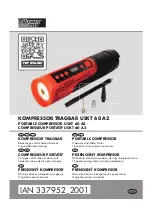
42
VII. Appendix- Miscellaneous Service Information
Exhaust Temperature Test
Exhaust temperature is measured with a pyrometer, thermo coupler, or infrared meter.
The temperature probe is installed in a straight section of the exhaust pipe approximately
6 inches from the turbo flange or manifold flange for naturally aspirated engines.
The reading is taken with the engine operating at rated output.
When the exhaust temperature is high, check the following: 1. Retarded timing. 2. Air
intake system restriction. 3. Excessive exhaust system back pressure.
When exhaust temperature is low, check the following: 1. Low compression. 2.
Inadequate fuel delivery from injection pump.
Crankcase Pressure Test (a.k.a. Blow-By Test)
Crankcase pressure is measured with a water manometer.
NOTE: 2 in. of water (or less) is normal. Pressure should never measure more than
2 in.
The manometer pickup tube is inserted into the oil level gauge tube, from which the level
gauge has been removed.
Do not insert the tube into the oil.
Do not attempt to seal
engine openings.
The reading is taken with the engine operating at rated output.
Inlet Manifold Pressure (Boost Pressure) Test
Boost pressure is to be measured with a mercury manometer. A pressure gauge may be
used when a manometer is not available. 1 inch of mercury =.49 PSI
The measuring device is to be installed in or straight run of the inlet air pipe. The most
desirable location is 6 inches from the inlet manifold flange.
The reading is taken with the engine operating at its peak rated output.
Specifications for these tests:
The results of all three of these tests will vary between engine models and between
specifications of the same model. To find the specifications applicable to your particular
engine, refer the Operation & Maintenance Manuals that came with the compressor.


































